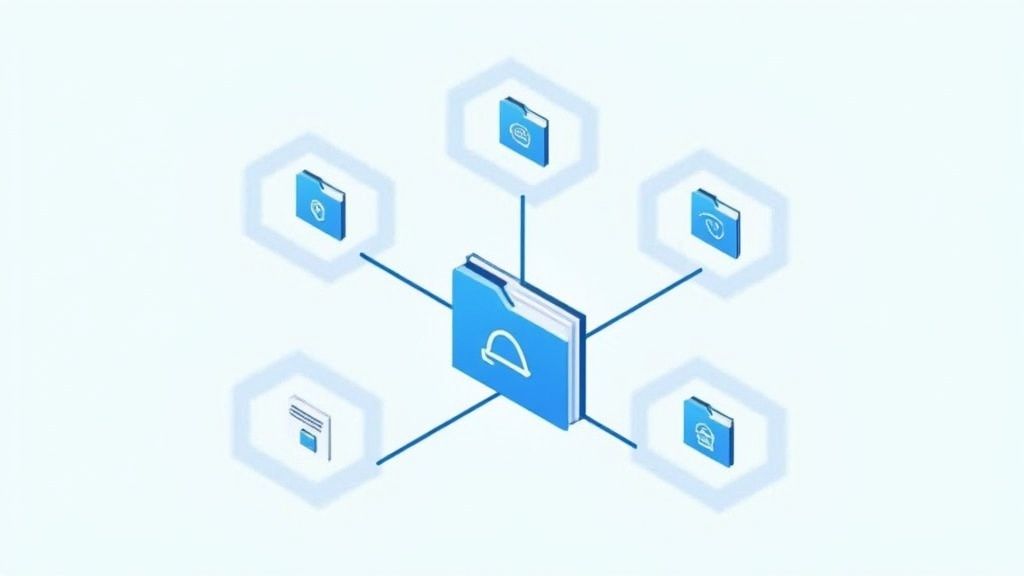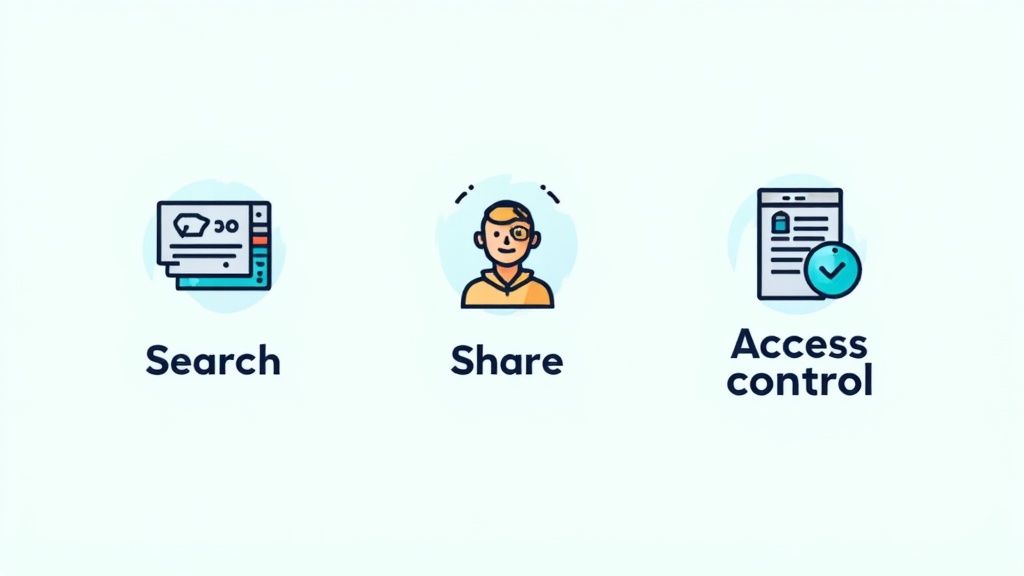Table of Contents
Let’s be honest, we’ve all been there. You’re trying to manage a big project, and your inbox is overflowing with email chains, each with a slightly different version of the same attachment. It’s a recipe for confusion, lost files, and a massive security headache. This is exactly where a document portal changes the game.
So, What Exactly Is a Document Portal?
Think of a document portal as a private, secure digital room for your most important files. It’s not just another cloud storage folder. It’s a dedicated online space where you, your clients, and your partners can safely share, review, and collaborate on documents.
Instead of tossing sensitive information into the digital wild west of email, you’re giving authorized people a key to a specific, controlled environment. They log in and see only the files that are relevant to them. This centralized approach brings order to the chaos and puts a lock on your sensitive data.
The Headaches a Document Portal Cures
A good portal solves some of the most frustrating problems that plague modern businesses:
- Messy File Sharing: It gets rid of those endless, confusing email threads and creates one central, organized hub for every document related to a client or project.
- Version Control Nightmares: No more wondering if you have “Final_v2” or “Final_v3_final.” Everyone is always looking at and working from the single, most current version of a file.
- Glaring Security Gaps: You can control who sees what, down to the individual file. This granular control, combined with robust encryption, slams the door on the security risks that make email so vulnerable.
A document portal isn’t just a digital filing cabinet. It’s a dynamic system for managing the flow of critical information. It creates a secure, efficient, and fully auditable bridge between you and the people you work with.
This screenshot shows a classic web portal layout. It’s a great visual for the core idea: bringing everything you need into one clean, unified space.
)
Just like this image aggregates different tools and information, a document portal brings all the necessary files and functions together in a single, secure gateway for your users.
Email Attachments vs. Document Portal Showdown
The real difference becomes crystal clear when you compare how each tool handles the tasks that matter most. Email is what we all know, but it was never built for the high-stakes world of secure business collaboration.
This quick table breaks down the essential differences:
| Feature | Email Attachments | Document Portal |
|---|---|---|
| Security | Low. Files sit unencrypted in multiple inboxes. | High. Encrypted, with granular access controls. |
| Version Control | Chaotic. Multiple versions scattered across emails. | Perfect. Everyone accesses the single, latest version. |
| Accessibility | Limited. Must search through old emails to find files. | Simple. Centralized access from any device, anytime. |
| Audit Trail | None. No record of who viewed or downloaded a file. | Complete. Full history of every action on every document. |
Ultimately, while sending an email attachment is quick, it lacks the security, control, and professionalism that a dedicated document portal provides. For any business serious about protecting client data and working efficiently, making the switch isn’t just an upgrade—it’s a necessity.
The Must-Have Features of a Modern Document Portal
Not all document portals are built the same. While lots of platforms can store files, a truly effective solution has a specific set of features that are there to protect your data, make workflows simpler, and build trust with your clients.
Think of it like buying a car. You could get a base model that just gets you from A to B. Or, you could invest in one with modern safety and performance features that make it a reliable partner you can count on. When you’re looking for a document portal, these are the non-negotiables that should be on your checklist. They’re what separate a simple online folder from a serious business tool.

Unbreakable Security and Access Control
Security is, without a doubt, the absolute foundation. We’re not just talking about files; we’re talking about confidential agreements, sensitive client information, and valuable intellectual property. This requires a lot more than just a password.
- Granular Access Controls: This is your ability to control exactly who sees what, and when. You should be able to give a client access to their project folder and nothing else, keeping all your other client data completely separate and private. This is non-negotiable for maintaining confidentiality.
- Bank-Grade Encryption: Your data needs to be locked down tight. That means it should be encrypted both while it’s sitting on a server (at rest) and while it’s being sent across the internet (in transit). This ensures that even if someone managed to intercept your data, it would be completely unreadable.
- Detailed Audit Trails: Think of this as a complete digital paper trail. An audit trail logs every single action taken inside the portal—who uploaded a file, who downloaded it, who viewed it, and exactly when they did it. This level of accountability is critical for compliance and for keeping an eye on internal security.
A key feature of modern document portals is advanced tracking capabilities, enabling users to monitor progress, a functionality visible in online visa application tracking systems. This level of visibility ensures nothing gets lost and everyone stays informed.
Everyday Usability and Efficiency
After security, the next most important thing is how the portal works day-to-day. It has to make life easier, not more complicated. The whole point is to get rid of frustrating manual tasks and automate the repetitive stuff, which frees up your team to focus on what really matters. You can learn more about how dedicated document collection software helps with this.
Here are the efficiency boosters to look for:
Powerful Search Functionality: Nobody has time to click through dozens of folders to find one document. A great portal has a smart search function that can instantly pull up files based on their name, the content inside them, or other tags.
Automatic Version Control: This feature puts an end to the nightmare of files named “Contract_Final_v2_APPROVED_final.” Every time a document is updated, the portal saves it as a new version without deleting the old ones. It’s a simple feature that guarantees everyone is always looking at the latest draft.
Seamless Integrations: Your document portal shouldn’t be an island. It needs to play nicely with the other tools you rely on every day, whether that’s your CRM, email client, or accounting software. Good integrations create a smooth, connected workflow so you aren’t constantly jumping between different apps.
How a Document Portal Boosts Your Bottom Line
Features are one thing, but let’s talk about what really matters: how does this technology actually help your business? A document portal is more than just a fancy tech upgrade. Think of it as a direct investment in your company’s efficiency, the trust you build with clients, and your overall financial health. It’s about turning abstract benefits into real, tangible results you can see on the balance sheet.
Let’s imagine a small but growing consulting firm. Before they have a portal, the team wastes hours every week just trying to find the latest version of a client proposal buried in a long email chain. That constant, frantic searching causes delays, makes the firm look disorganized, and, worst of all, eats up valuable billable hours.
Now, picture that same firm after getting a document portal. Proposals, contracts, and project reports are all neatly organized in one central, secure spot. Clients get their own private login, which builds their confidence and makes the firm look incredibly professional. The team gets its time back, allowing them to focus on what they do best—delivering great work—instead of just hunting for files.

Streamlining Workflows for Greater Productivity
Messy, disorganized processes are the silent killers of profit. When document management is chaotic, it can drag down productivity by a surprising amount—some estimates point to a drop of over 21%. A document portal hits this problem head-on by creating clear, repeatable systems for how information moves through your business. (If you want to dive deeper into this, our guide on document workflow automation is a great resource).
This structured approach pays off in a few key ways:
- Reduced Administrative Work: Automatic reminders for document submissions or expirations mean your team isn’t stuck chasing people down.
- Faster Turnaround Times: When everything is in one place, getting documents reviewed and approved happens much more quickly. No more bottlenecks.
- Improved Team Collaboration: Everyone is working from the same playbook. This puts an end to the confusion and mistakes that come from having multiple versions of the same file floating around.
Enhancing Security and Ensuring Compliance
Beyond making you more efficient, a document portal acts as a critical shield for your business. Data breaches are a constant threat, and showing you have strong security isn’t just a good idea anymore—it’s a major selling point. This is especially true in specialized industries where clients are hyper-aware of data protection. Consider this: around 7.5% of all paper documents get lost forever, a risk that a secure digital system almost completely eliminates.
By centralizing sensitive information within a secure portal, you’re not just organizing files. You’re building a fortress around your most valuable assets and demonstrating a commitment to protecting client data, which is essential for long-term trust.
This commitment is also vital for navigating the maze of government regulations. If your business handles personal data, complying with rules like GDPR or HIPAA is absolutely non-negotiable. A document portal gives you the tools you need—like strict access controls and detailed audit trails—to prove you’re compliant, helping you avoid massive fines and damage to your reputation.
Ultimately, it turns a potential headache into a way to showcase how diligent and reliable your company is. The conclusion is simple: a secure, efficient document portal pays for itself through saved time, lower risk, and happier, more confident clients.
Real-World Document Portal Use Cases
Features and tech specs are one thing, but the real test of a document portal is how it performs in the wild. This is where the theory ends and practical value begins. A portal isn’t just a piece of software; it’s a flexible tool that completely changes shape depending on the industry it’s serving.
Whether it’s handling sensitive client files or untangling complex corporate workflows, its impact is immediate and undeniable.

Let’s get specific. Think about an accounting firm buried in work during tax season. A document portal becomes their command center. Instead of juggling risky email attachments, each client gets their own private, branded login. Here, they can securely upload W-2s, receipts, and other essentials, and even see the real-time status of their return. It’s a simple change that builds massive trust while cutting down on administrative busywork.
Or take a legal team, where a single document can make or break a case. A portal gives them pinpoint control over case files, discovery documents, and contracts. Attorneys can set granular permissions, giving paralegals, clients, or opposing counsel access only to specific folders. Every single view, download, and change is logged, creating a bulletproof audit trail.
Specialized Industry Applications
The need for this kind of secure, organized system extends far beyond just finance and law. The right platform can rescue any workflow traditionally drowning in paperwork and endless manual follow-ups.
Look at these high-stakes environments:
- Healthcare: To maintain strict HIPAA compliance, medical providers use portals to safely share patient records, lab results, and billing info with patients and other doctors.
- Real Estate: Closing on a property involves a storm of paperwork flying between buyers, sellers, agents, and lenders. A portal corrals everything—from the initial offer to the title insurance—into one central, undisputed hub.
- Corporate Governance: Boards of directors rely on specialized board portals to securely distribute agendas, sensitive financial reports, and strategic plans before a big meeting, keeping confidential information locked down.
A document portal is more than just a digital filing cabinet. It’s a controlled environment built for high-value information. It molds itself to industry rules and client expectations, turning a process that’s often a liability into a real professional advantage.
For instance, a construction manager can use a portal to manage blueprints, subcontractor agreements, and safety certifications. Each vendor gets a login that only shows them the documents relevant to their part of the job. This prevents costly mix-ups and makes sure everyone is literally on the same page. For massive projects, that level of organization is what keeps things on schedule and on budget.
The common thread here? Control. A document portal gives a business the power to dictate who sees what, track every interaction, and offer a polished, professional experience for every client and partner. It swaps the chaos of document management for structured, secure, and efficient workflows that are tailor-made for the job at hand.
How to Choose the Right Document Portal

Choosing a document portal feels like a huge commitment, but it doesn’t have to be intimidating. The secret is to stop getting distracted by fancy bells and whistles and focus on what your team actually needs to get their work done. If you approach it methodically, you’ll find a tool that actually helps your business run smoother, not one that just adds another layer of complexity.
Before you even start looking at demos, take a hard look at your current workflow. Where are things getting stuck? What administrative tasks are eating up everyone’s time? Pinpointing these headaches gives you a concrete list of “must-haves” for any new system. For example, if your team is constantly chasing clients for missing paperwork, then a portal with automated reminders should be at the very top of your list. Our guide on how to master document collection can help you spot these opportunities.
Define Your Core Requirements
Once you know what problems you need to solve, you can build a simple scorecard to measure different vendors against. This isn’t about finding a portal that does everything under the sun. It’s about finding the one that does the things you need it to do, and does them really well.
Here are the non-negotiables to build your evaluation around:
- Security and Compliance: Does it have strong encryption, clear audit trails, and the ability to control who sees what? This is your foundation. No compromises here.
- User Experience (UX): Is it easy to use? Not just for your tech-savvy team members, but for your clients, too. A clunky, confusing portal won’t get used, and all its potential benefits will go right out the window.
- Integration Capabilities: How well does it play with the other software you rely on, like your CRM or accounting tools? A portal that connects to your existing systems prevents information from getting trapped and keeps everything flowing smoothly.
Assess Scalability and Deployment Models
Your business isn’t static, and your document portal shouldn’t be either. You need a solution that can grow with you. A system that works perfectly for a team of five might completely fall apart when you hit fifty. Ask vendors how the platform handles more users, more storage, and higher document volumes. You don’t want performance to drag or the price to skyrocket unexpectedly.
You’ll also need to decide on the deployment model. This choice is usually a trade-off between control, cost, and convenience.
- Cloud-Based (SaaS): The vendor hosts everything, and you access it through your browser. This means lower upfront costs, no maintenance headaches, and easy access from anywhere. It’s the most flexible and popular option for a reason.
- On-Premise: You install and run the software on your own servers. This gives you total control over your data and customization, but it comes with a hefty initial price tag and requires a dedicated IT team to manage it.
The global market for document management systems is expected to reach USD 18.40 billion by 2030. Much of that growth comes from companies embracing flexible cloud solutions that can support remote teams and changing workloads. However, on-premise systems remain essential for industries where having direct control over data is a strict requirement.
At the end of the day, the right document portal is the one that fits your real-world processes, meets your security standards, and respects your budget. By taking the time to evaluate your options this way, you can confidently choose a tool that will empower your team and improve your client experience for the long haul.
Common Questions About Document Portals
It’s smart to have questions when you’re looking at a new tool like a document portal. You need to know if it’s the right move for your team, your clients, and your bottom line. Let’s walk through some of the most common things business owners ask before they switch to a more secure and organized way of working.
Getting straight answers helps you make a confident decision, ensuring you pick a solution that actually solves your problems instead of creating new headaches.
“Isn’t a Document Portal Just Fancy Cloud Storage?”
I hear this one all the time, and it’s a great question because it gets right to the heart of what these tools do. While a document portal and a service like Dropbox or Google Drive both store files online, they are built for fundamentally different jobs.
Think of it like this: cloud storage is a digital garage. It’s a fantastic, flexible place to dump your stuff, but there’s no real system built into it. You put things in, you take things out, and you can give someone a key. But you have very little control over what they do once they’re inside, and it’s certainly not designed for a structured process.
A document portal is more like a secure bank vault with a helpful teller.
It’s not just a place to keep things; it’s a controlled environment designed around specific, secure workflows. It guides the entire journey of a document—from requesting it, to submission, review, approval, and finally, secure storage. The focus is squarely on security, process, and the client experience.
Here’s where they really differ:
- Granular Permissions: Portals let you control exactly who can see or do what, right down to a single file. You can’t accidentally share the whole “folder” with the wrong person.
- Audit Trails: You get a complete, unchangeable history of every action taken on a document. Who viewed it? Who downloaded it? When? It’s all tracked.
- Branded Experience: You can customize the portal with your own logo and colors. This makes your business look professional and gives clients a sense of trust and security.
“What Does Something Like This Typically Cost?”
The price for a document portal can really vary depending on what you need. Most companies offer a subscription, usually billed monthly or annually. The cost is typically tied to things like how many users are on your team, how much storage you’ll use, and which advanced features you need.
For a small team, a basic plan might start at a pretty low monthly fee. A larger company with complex compliance rules or integration needs will naturally invest more. The trick is to find a provider with clear, scalable pricing so you don’t end up paying for a bunch of features you’ll never touch. Many also offer free trials, which are the best way to kick the tires and see if it works for you before you commit.
“How Difficult Is It to Get My Team Onboard?”
The thought of rolling out new software can be stressful, but modern document portals are built to be user-friendly from the get-go. The best ones have simple, intuitive designs that require very little training for your team and especially for your clients.
Getting started is usually pretty straightforward:
- Setup: An admin configures the portal, adds your company branding, and maybe sets up a few document templates you use all the time.
- Team Training: For most teams, a quick walkthrough is all it takes. The main functions—uploading, viewing, and commenting—feel familiar to anyone who’s used a computer in the last decade.
- Client Invitation: Inviting clients is as easy as sending an email with a link. Their job is even simpler, usually just uploading or viewing files, so it requires almost no instruction on their part.
The whole point of a good document portal is to make work easier, not add another complicated step. A well-designed system should feel natural to use within hours, not weeks, so your team starts seeing the benefits right away.
Ready to stop chasing documents and start creating smooth, professional workflows? Superdocu offers a secure, user-friendly document portal designed to automate your collection process and impress your clients. Start your free trial today and see the difference.
